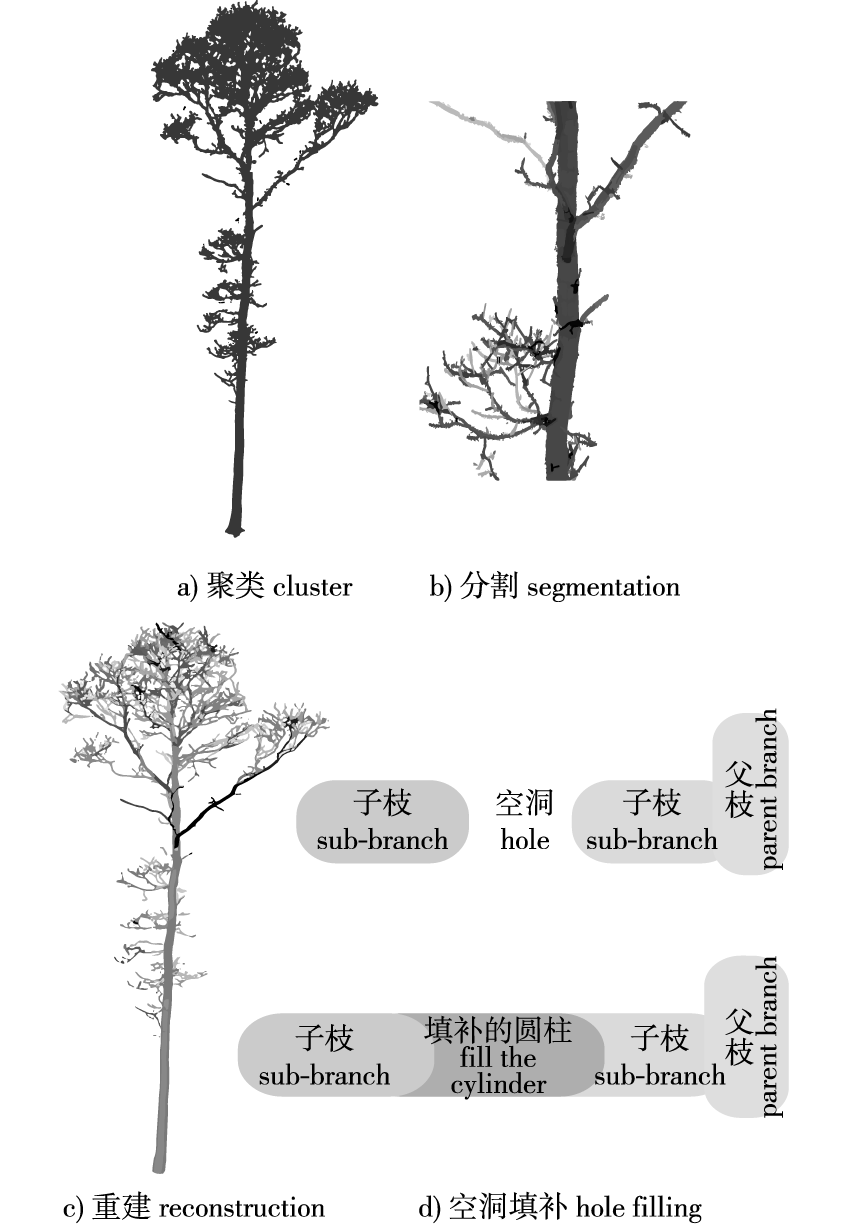 PDF(2706 KB)
PDF(2706 KB)


基于QSM的落叶松一级枝条数量提取与模型构建
彭文越, 贾炜玮, 王帆, 李鑫, 李丹丹
南京林业大学学报(自然科学版) ›› 2025, Vol. 49 ›› Issue (2) : 185-193.
 PDF(2706 KB)
PDF(2706 KB)
 PDF(2706 KB)
PDF(2706 KB)
基于QSM的落叶松一级枝条数量提取与模型构建
Extraction and construction of a QSM-based model of first-order branches of Larix gmelinii plantations
【目的】基于地基激光雷达(terrestrial laser scanning,TLS)点云数据,应用定量结构模型(quantitative structural model,QSM)以全自动的方式提取落叶松不同相对着枝深度处一级枝条的数量,构建一级枝条密度的线性混合预测模型,为落叶松冠层研究提供理论基础。【方法】基于30株落叶松(Larix gmelinii)TLS数据,应用QSM算法获取树木结构参数,将提取值与实测值进行回归分析,探究点云数据建模的准确性。采用点云分层方法探究不同相对着枝深度处一级枝条数量的提取精度。以Poisson回归模型作为基础的计数模型,建立基于样木效应的一级枝条密度最优混合模型,并对模型进行评价。【结果】30株落叶松一级枝条数量的平均提取精度为80.71%,均方根误差(RMSE)为6.9594。不同冠层的一级枝条数量提取结果存在差异,相对着枝深度范围在(0.7,0.8]的提取效果最好,平均精度为87.78%。一级枝条密度的最优模型为基于样木效应的混合模型;枝条密度的最优模型为基于相对着枝深度的自然对数[ln(RDINC)]、相对着枝深度的平方(RDINC2)、高径比(HT/DBH)3个随机效应参数的线性混合模型(R2=0.745 4、均方根误差为0.229)。【结论】基于地基激光雷达扫描数据,通过定量结构模型获取单木的分枝结构参数,该方法具有适用性和可靠性。基于样木效应建立落叶松一级枝条的密度混合模型,不仅可以反映冠层内一级枝条的分布密度变化,还可以预测树冠整体的生长趋势。
【Objective】The quantitative structural model (QSM) algorithm was used to extract the number of first-order branches at different relative branch depths using a fully automatic strategy based on terrestrial laser scanning (TLS) point cloud data. A linear mixed prediction model of first-order branch density was constructed to provide a theoretical basis for research studies on Larix gmelinii plantation canopies. 【Method】 The TLS data of 30 L. gmelinii plantations and the QSM algorithm were used to obtain parameters pertaining to tree structure, and the extracted and measured values were subjected to regression analysis for exploring the accuracy of modeling based on point cloud data. The extraction accuracy of the method used for determining the number of first-order branches at different relative branch depths was assessed using the point cloud layering method. The optimal mixing model of the first-order branch density of the sample tree effect was constructed using the Poisson regression model, and the model was evaluated. 【Result】 The average extraction accuracy of the model constructed based on 30 L. gmelinii plantation branches was 80.71%, and the RMSE was 6.959 4. There were differences among the number of first-order branches extracted from different canopies, and the best results were obtained when the relative branch depth ranged from 0.7 to 0.8. The average accuracy was 87.78%, and a mixed model based on the sample tree effect was found to be optimal for determining the first-order branch density. The optimal model of branch density was a linear mixed model based on three random effect parameters, namely natural logarithm of the relative branching depth [ln(RDINC)], square of the relative branching depth (RDINC2), and ratio of tree height to breast diameter [HT/DBH], and the values of R2 and RMSE were 0.745 4 and 0.229, respectively. 【Conclusion】 The parameters pertaining to the branch structure of individual trees were obtained based on the ground-based laser radar scanning data, using the quantitative structure model that was applicable or reliable. Based on the effects observed in the sample wood, the density mixed model of the first-order branches of L. gmelinii plantations not only reflects the changes in the distribution density of the primary branches in the canopy, but can also predict the overall growth trend of the crown.

落叶松 / 点云数据 / 一级枝条数量 / 定量结构模型(QSM) / 线性混合模型
Larix gmelinii / point cloud data / number of first-order branches / quantitative structural model (QSM) / linear mixed model
| [1] |
刘兆刚, 刘继明, 李凤日, 等. 樟子松人工林树冠结构的分形分析[J]. 植物研究, 2005, 25(4):465-470.
|
| [2] |
陈东升, 金钟跃, 李凤日, 等. 樟子松节子的大小及分布[J]. 东北林业大学学报, 2007, 35(5):19-21.
|
| [3] |
|
| [4] |
|
| [5] |
夏明鹏, 官凤英, 范少辉, 等. TLS技术在森林资源调查中的应用现状与展望[J]. 西北林学院学报, 2018, 33(3):238-244.
|
| [6] |
曹伟, 陈动, 史玉峰, 等. 激光雷达点云树木建模研究进展与展望[J]. 武汉大学学报(信息科学版), 2021, 46(2):203-220.
|
| [7] |
|
| [8] |
|
| [9] |
梁晓军, 庞勇, 陈博伟. 基于地基激光雷达胸径提取的单木位置精确测量[J]. 林业科学研究, 2020, 33(4):67-74.
|
| [10] |
|
| [11] |
|
| [12] |
刘芳, 冯仲科, 杨立岩, 等. 基于三维激光点云数据的树冠体积估算研究[J]. 农业机械学报, 2016, 47(3):328-334.
|
| [13] |
|
| [14] |
|
| [15] |
|
| [16] |
|
| [17] |
|
| [18] |
刘兆刚, 李凤日. 樟子松人工林树冠内一级枝条空间的分布规律[J]. 林业科学, 2007, 43(10):19-27.
|
| [19] |
苗铮, 董利虎, 李凤日, 等. 基于GLMM的人工林红松二级枝条分布数量模拟[J]. 南京林业大学学报(自然科学版), 2017, 41(4):121-128.
|
| [20] |
王曼霖, 董利虎, 李凤日. 基于Possion回归混合效应模型的长白落叶松一级枝数量模拟[J]. 北京林业大学学报, 2017, 39(11):45-55.
|
| [21] |
贾炜玮, 罗天泽, 李凤日. 基于抚育间伐效应的红松人工林枝条密度模型[J]. 北京林业大学学报, 2021, 43(2):10-21.
|
| [22] |
|
| [23] |
|
| [24] |
|
| [25] |
|
| [26] |
李春明. 基于纵向数据非线性混合模型的杉木林优势木平均高研究[J]. 林业科学研究, 2011, 24(1):68-73.
|
| [27] |
|
| [28] |
|
| [29] |
张颖, 贾炜玮. 基于地基激光雷达的落叶松人工林枝条因子提取和建模[J]. 应用生态学报, 2021, 32(7):2505-2513.
|
| [30] |
王帆, 贾炜玮, 唐依人, 等. 基于TLS的红松树冠半径提取及其外轮廓模型构建[J]. 南京林业大学学报(自然科学版), 2023, 47(1):13-22.
|
/
| 〈 |
|
〉 |